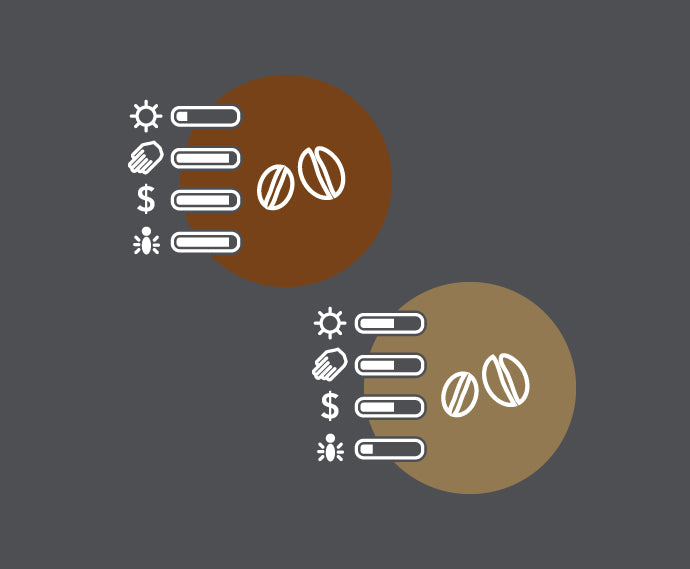ENJOY 25% OFF VERONA COFFEE CAPSULES

Coffee is the world’s most popular drink. Around the world, it is estimated that a staggering two billion cups are drunk every single day.
Although there are over one hundred coffee species in existence, each with their own distinct characteristics, two types of coffee beans account for around 98% of total production globally.
These two types of coffee beans are known as Arabica and Robusta.
Just Why Are Arabica Coffee Beans So Popular?
It is believed that Arabica coffee beans were the first coffee plants to be cultivated by humans. Its long history has been documented stretching as far back as the 12th century.
Arabica beans are popular for their sweet taste. This is due to the fact that caffeine is quite bitter and the caffeine content of Arabica is comparatively lower than that of Robusta.
Arabica coffee beans make up 70% of the total global coffee production
Originally native to the mountain ranges of Ethiopia, Arabica coffee beans now make up approximately 70% of the total global coffee production. Coffee farmers still grow Arabica beans in Ethiopia, making the country the world’s third-largest producer.
The top two major producers of Arabica are Brazil and Colombia as the bulk of the annual crop comes from these regions in South America.
Arabica Requires Very Careful Cultivation
Arabica is a crop that grows well in mountainous regions, but it is sensitive to variables such as heat, humidity and soil quality. Arabica grows best at altitudes ranging between 600 and 2000 metres above sea level.
Harvesting coffees at such a high altitude means the process is more labour intensive, which in turn pushes up the cost of producing Arabica coffees. Arabica also has a lower yield than other coffee varieties and is susceptible to coffee leaf rust and coffee berry disease, contributing to the premium price of Arabica beans.
Arabica Bean Varietals
The characteristics of Arabica coffee differs between varietals. According to the World Coffee Research organisation, there are ‘dozens’ of Arabica coffee varietals available to coffee farmers to choose from. Similarly to wine production, growers select the best types of coffee beans to cultivate according to the coffee plant’s adaptability and performance in local growing conditions.
Typica and Bourbon varietals
Most Arabica plants are descendants of the Typica and Bourbon varietals. Typica is well adapted to colder climates and produces a tall-growing, quality crop at high altitude. It's particularly popular in Central America.
Like Typica, Bourbon is also a tall-growing plant that flourishes at the highest altitudes. Varieties that descend from Bourbon are grown widely in South and Central America.
Although Bourbon has largely been replaced in Latin America, it is still cultivated in countries such as Guatemala, El Salvador, Peru and Honduras.
Coffee Growing Really Is An Art
Selecting the right variety of coffee to grow in any given location is essential to successful cultivation. A coffee farmer needs to take multiple factors into account including the local climate, the soil condition and previous land use. Other considerations include the method of harvesting, crop irrigation and pruning.
Shade management is especially critical to Arabica coffee bean cultivation. Too much direct sun can damage the plant. Over time, this can lead to reduced yield. Some farmers provide shade for coffee plants by intercropping the coffee with avocado, cocoa, nut or banana trees that produce natural shade.
Soil quality must also be carefully managed. To produce a good crop, coffee farmers need to manage soil quality and the addition of nutrients such as nitrogen and phosphorus. They also need to carefully space plants to suitably allow for pruning which prolongs the productive lifespan of coffee plants.
Robusta Coffee Beans Have A Lot More To Offer Than Instant Coffee
Robusta coffee has its origins in central and sub-Saharan Africa, but is now widely grown in Vietnam and India. It is a coffee that has a high caffeine content and a more bitter flavour when compared to Arabica.
Historically it has mainly been used in instant coffee blends. However as global warming and plant disease impacts the world’s coffee production, the Robusta variety and its resilient nature have a lot to offer.
Robusta Coffee Beans are Easier to Cultivate than Arabica
To directly compare the ease of cultivating Arabica and Robusta, the latter grows more quickly in more extreme climates. It also enjoys greater disease resistance than Arabica coffee. This reliability is crucial to coffee farmers around the world.
The coffee industry is naturally looking to the more resilient and disease resistant Robusta variety to continue to keep up with global demand.
Perception of Robusta Coffee is Changing for the Better
Despite its history as a bitter bean used in instant coffee granules, Robusta is now being successfully repositioned in the quality segment of the coffee market. Fine Robusta Standards and Protocols have been published to drive quality improvements and positive customer perception of Robusta coffee.
Thanks to initiatives such as this, Robusta coffee continues to grow in popularity.
Whilst some coffee aficionados may prefer to stick to the complexity of the Arabica bean, the quality of Robusta coffee is continuing to reach new highs and coffee roasters are relishing the opportunity to explore the intricacies of high-quality, premium Robusta beans.
Sources
https://caffeinevibe.com/arabica-and-robusta-coffee-beans
https://www.bbc.co.uk/news/resources/idt-fa38cb91-bdc0-4229-8cae-1d5c3b447337
https://farrerscoffee.co.uk/are-arabica-coffee-beans-the-best
https://en.wikipedia.org/wiki/Coffea_arabica#cite_note-CoffeeProduction-1
